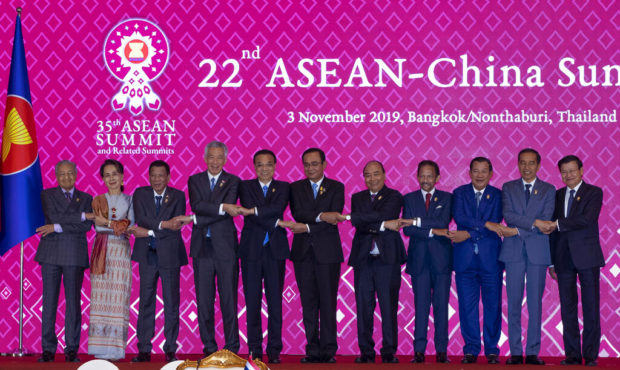Sans Trump, Asean charts path for China-led trade bloc

Chinese Premier Li Keqiang, fifth from left, shake hands with ASEAN leaders, from left, Malaysian Prime Minister Mahathir Mohamad, Myanmar State Counsellor Aung San Suu Kyi, Philippines President Rodrigo Duterte, Singapore Prime Minister Lee Hsien Loong, Thailand Prime Minister Prayuth Chan-ocha, Vietnam Prime Minister Nguyen Xuan Phuc, Brunei Sultan Hassanal Bolkiah, Cambodia Prime Minister Hun Sen, Indonesia President Joko Widodo, and Laos Prime Minister Thongloun Sisoulith during ASEAN-China summit in Nonthaburi, Thailand, Sunday, Nov. 3, 2019. (AP Photo/Gemunu Amarasinghe)
NONTHABURI, Thailand — Leaders from fast-growing Southeast Asian economies, China, Japan and other regional powers are aiming for a breakthrough on a free trade deal and an outline for handling territorial disputes in the South China Sea at an annual summit that opened near Bangkok on Sunday.
Thai Prime Minister Prayuth Chan-ocha addressed the gathering of the Association of Southeast Asian Nations (Asean) by saying the group intended to reach a basic agreement on the Regional Comprehensive Economic Partnership, a 16-member trade bloc encompassing nearly a third of all global trade.
Code of conduct
Prayuth said the aim was to have a final deal by next year.
Asean also hopes to set a code of conduct with China regarding disputed waters in the South China Sea, he said.
US President Donald Trump skipped the Asean summit and related meetings this year, opting to send his national security adviser, Robert O’Brien, instead.
Last year, Trump sent Vice President Mike Pence. This year both are busy campaigning back home.
Chinese Premier Li Keqiang told other leaders attending that Beijing was committed to 10-nation Asean’s central role in the region.
“Given the complexity in the international and regional situation, our cooperation is built on a stable structure and moving forward in a positive fashion,” Li said. “This is beneficial to the region and all parties involved.”
“We support stability in the region and by doing so we have been able to cope with the instability elsewhere in the world,” Li said.
On the long-troublesome issue of the South China Sea, Li welcomed progress in efforts by China and Asean to negotiate a regional “code of conduct,” which aims to tame aggressive actions that could set off armed confrontations in one of the world’s most disputed regions.
‘Important landmark’
After being accused of delaying the start of talks for years while building artificial islands with military outposts on contested reefs, China agreed to commence negotiations and both sides announced that the first of three expected rounds was concluded in July.
Li called that progress “a very important landmark” for regional stability. He said China was committed to making headway in the negotiations with Asean members, four of which—Brunei, Malaysia, the Philippines and Vietnam—are locked in the territorial disputes.
But the talks are highly contentious and many doubt China is ready to sign a code that many governments, including the United States, hope will be legally binding and potent enough to restrain provocative actions in a busy waterway crucial to global commerce.
On the issue of trade, Asean officials plan to present to the leaders a report on regional trade deal negotiations.
A draft of that report seen by The Associated Press says talks should be finalized by February 2020 and endorsed by leaders of member countries at next year’s summit, which is due to take place in Vietnam.
Asean groups together Brunei, Cambodia, Indonesia, Laos, Myanmar, Malaysia, the Philippines, Singapore, Thailand and Vietnam. Together, they comprise a fast-growing regional market of nearly 650 million people.
The proposed trade bloc aims to dismantle trade barriers and set standards for trade between Asean and six other nations: China, Japan, India, Australia, New Zealand and South Korea.